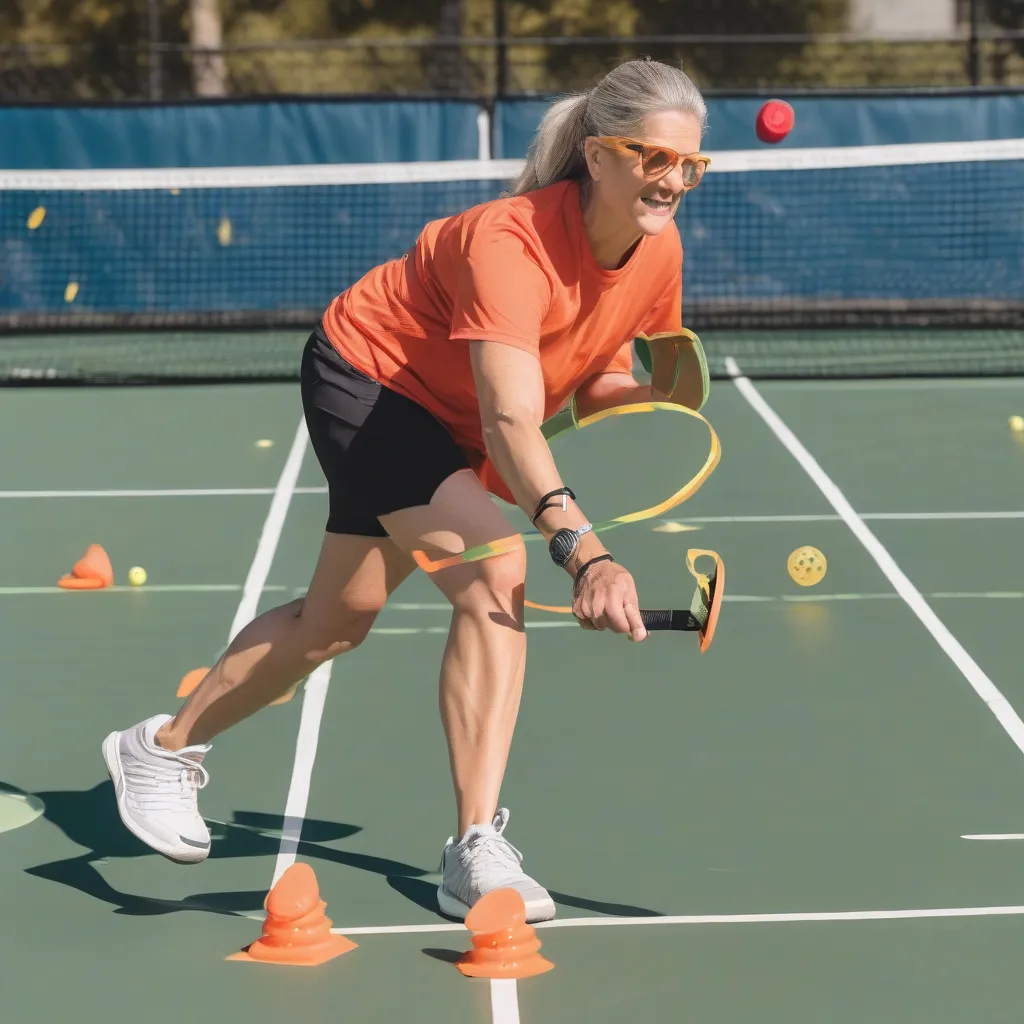Table of Contents
Introduction to Pickleball Footwork Drills
Footwork is a crucial aspect of pickleball that significantly impacts your ability to move efficiently, maintain balance, and execute shots accurately. By incorporating specific pickleball footwork drills into your practice routine, you can enhance your agility, speed, and overall performance on the court. This guide presents the top 10 footwork drills to help you improve your game.
Why Footwork is Essential in Pickleball
Effective footwork allows you to:
- Reach Shots Efficiently: Proper footwork helps you position yourself quickly to hit the ball with precision.
- Maintain Balance: Good footwork ensures you stay balanced while executing shots, reducing the risk of errors.
- Conserve Energy: Efficient movement conserves energy, allowing you to play longer and maintain a high level of performance.
- Control the Court: Strong footwork enables you to control the pace of the game and dominate your opponent.
Top 10 Pickleball Footwork Drills
1. Lateral Shuffles
Lateral shuffles improve your side-to-side movement, essential for reaching wide shots. Stand at the center of the baseline and shuffle to the right sideline and back, then to the left sideline and back. Repeat for 1-2 minutes.
2. Forward and Backward Sprints
Enhance your ability to move forward to the net and back to the baseline. Sprint from the baseline to the non-volley line and back, focusing on quick, explosive movements. Repeat for 1-2 minutes.
 Pickleball Footwork Drills
Pickleball Footwork Drills
3. Cone Drills
Set up cones in a zigzag pattern across the court. Sprint to each cone, touch it, and move to the next one. This drill improves your agility and change of direction.
4. Split Step Practice
The split step is a small hop you make just before your opponent hits the ball, preparing you to move in any direction. Practice this movement by jumping slightly and landing on the balls of your feet, ready to move quickly.
5. Figure Eight Drill
Place two cones a few feet apart. Move in a figure-eight pattern around the cones, maintaining low, quick steps. This drill enhances your ability to change direction swiftly.
6. Ladder Drills
Use an agility ladder to perform various footwork patterns, such as the high knees, in-out shuffle, and lateral steps. These drills improve your speed, coordination, and foot placement.
7. Box Drill
Create a box with four cones. Starting at one corner, shuffle to the next cone, then backpedal, shuffle, and sprint to complete the box. This drill works on multiple directions and quick transitions.
8. Quick Feet Drill
Stand in place and rapidly alternate lifting your feet, focusing on quick, small movements. This drill increases your foot speed and readiness.
9. Cross Over Step
From a ready position, step across your body with one foot to move laterally, then bring the trailing foot over. Practice moving both to the left and right to improve lateral coverage.
10. Shadow Drills
Imagine playing against an opponent and mimic their shots, moving accordingly. This drill helps you practice real-game movements and improve your reaction time.
Tips for Effective Footwork Drills
To maximize the benefits of your footwork drills, keep these tips in mind:
- Consistency: Practice regularly to develop muscle memory and improve your footwork.
- Focus on Form: Maintain proper form during drills to prevent injuries and ensure effective movement.
- Increase Intensity Gradually: Start with slower movements and gradually increase the speed and intensity of your drills.
- Stay Light on Your Feet: Keep your weight on the balls of your feet to enhance agility and quickness.
- Combine Drills: Mix different drills to work on various aspects of footwork and keep your practice sessions engaging.
Common Mistakes to Avoid in Footwork Drills
To ensure your footwork drills are effective, avoid these common mistakes:
- Overtraining: Balance your training with rest to prevent overuse injuries.
- Neglecting Warm-Up: Always warm up before starting footwork drills to prepare your muscles and joints.
- Skipping Cool-Down: Cool down after your drills to aid in recovery and reduce muscle soreness.
- Ignoring Footwear: Wear proper court shoes that provide support and traction for your footwork drills.
- Lack of Focus: Pay attention to your movements and technique to maximize the benefits of each drill.
Resources for Further Learning
To continue improving your pickleball footwork, explore these valuable resources:
- For comprehensive guides and tips, visit the USA Pickleball Association (USAPA).
- Explore instructional videos and articles on Pickleball Central.
- For detailed tutorials and practice routines, check out Pickleball Portal.
- Learn from top players and coaches on PickleballMAX.
Conclusion
Improving your pickleball footwork is essential for enhancing your performance and overall game. By incorporating these top 10 footwork drills into your practice routine, you can develop agility, speed, and balance, allowing you to move more efficiently on the court. Use the resources provided to further your knowledge and continuously refine your skills. With dedication and consistent practice, you’ll become a more agile and effective pickleball player.
Frequently Asked Questions
- Why is footwork important in pickleball? Footwork is crucial for positioning yourself quickly and efficiently to hit shots accurately and maintain balance.
- How often should I practice footwork drills? Aim to practice footwork drills at least 3-4 times a week to see significant improvement.
- What are the best shoes for pickleball footwork drills? Choose court shoes that provide good support, traction, and comfort, specifically designed for lateral movements.
- How can I improve my agility for pickleball? Regularly practice footwork drills, focus on maintaining proper form, and incorporate agility exercises into your fitness routine.
- Where can I find more information on pickleball footwork drills? Visit the USA Pickleball Association, Pickleball Central, Pickleball Portal, and PickleballMAX websites for comprehensive guides, tips, and tutorials.